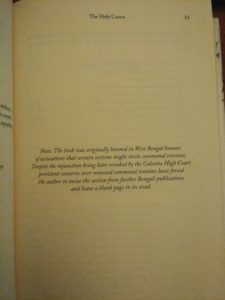Taslima Nasrin’s “Split: A Life”
…the director general [ of the Bangla Academy] raised his eyebrows and turned to me…’Despite being a woman why do you try and write like a man?….’
‘Why should I write like a man? I write what I feel,’ I countered immediately.
This exchange between the Bangladeshi writer Taslima Nasrin and the Bangla Academy director general Harunur Rashi takes place at a book fair where a procession had been organised by the Taslima Nasrin Suppression Committee, “to quash the nefarious ‘sex writer’ Taslima Nasrin”. This incident happened on 17 February 1992.
On 6 December 1992 after the destruction of the Babri Masjid there were communal clashes in India and Bangladesh. Taslima Nasrin was deeply disturbed by the riots and wrote Lajja ( Shame). It was a book which made her an international name even though it was banned in Bangladesh shortly thereafter.
Her memoir Dwikhondito ( 2003) now translated as Split: In Two by Maharghya Chakraborty met a similar fate  when it was banned in West Bengal, India. It was banned by the West Bengal government for allegedly hurting sentiments of the Muslim community. The government lifted injunction after the ban was struck down by the Calcutta High Court in 2005. Yet in the English edition of the memoir published by Penguin Random House India there is a blank page with a note by the author.
when it was banned in West Bengal, India. It was banned by the West Bengal government for allegedly hurting sentiments of the Muslim community. The government lifted injunction after the ban was struck down by the Calcutta High Court in 2005. Yet in the English edition of the memoir published by Penguin Random House India there is a blank page with a note by the author.
Split is a memoir by an author who achieved fame fairly early on in her literary career. It is not very clear if the memoir was written at one go or over a period of time. There is no author’s note or a translator’s note in the book making it a little challenging to figure out the context. The memoir is presented as more or less a chronological narrative of a writer’s awakening, not necessarily an autobiographical account of Taslima Nasrin. Reading it from cover to cover a confident tenor to the writing is discernible particularly after Taslima Nasrin wins the Ananda Puraskar in early 1990s. It is a watershed moment in her literary career not least because she was the first writer from Bangladesh to have been awarded what is considered to be the Nobel Prize of Bengali literature. Writers senior to her in age and work had been ignored. The change in her writing style is apparent not only in the manner in which she asserts herself in company with other writers, shares her views on a variety of subjects and takes the social responsibility of an author seriously. She is at the same time grappling with the very serious threat to her life on the basis of her writing and despite her mother’s pleas Taslima Nasrin never tempers her tone.
A snippet from her acceptance speech of the Ananda Puraskar illustrates why her feminist views were not being tolerated in an increasingly conservative society.
Our scriptures and ther rules governing our society would like to reinforce one primary fact: that women cannot have independence. But a woman who is not physically and mentally independent cannot claim to be a complete human being either. Freedom is primary and a woman’s freedom has now been put under arrest by the state, with religion being the chief impediment to her natural growth. Because religion is there most women are still illiterate, deprived of property, more are married off when they are children and are victims of polygamy, talaq and widowhood. Because men wish to serve only their own ends, they have defined and valourized a woman’s feministy, chastity and maternal instincts.
There are many sections in the book that are fascinating to read for the insight it offers in the evolution of a woman writer particuarly when Taslima Nasrin chooses to reflect. There is an almost meditative quality to her writing in those passages that haunt her writing. These are the better parts in Split as compared to the long sections about her relationships and her family which tend to meander. These instances are significant for her growth as an individual and as a writer since with each relationship she realises what exactly she desires, and it is not always male companionship. Unfortunately these sections are not as well written as those in which she comments upon literature, Bengali literary society in Bangladesh and West Bengal and reflects upon what interests her as a writer.
Split will probably be viewed in coming years as seminal as the writing by other women writers from the subcontinent such as Salma’s Hour Past Midnight and Bama’s Karukku. Taslima Nasrin’s Split‘s relevance to contemporary politics in the subcontinent and not just Bangladesh for the issues it raises about censorship, women’s rights, religious intolerance, freedom of speech, right to live and equality among men and women are critical particularly in this age of religious fundamentalism blowing across nations.
Spare some time and read it.
Taslima Nasrin Split: A Life ( translated by Maharghya Chakraborty) Hamish Hamilton, an imprint of Penguin Random House India, 2018. Hb. pp. 502. Rs. 599
19 March 2018
